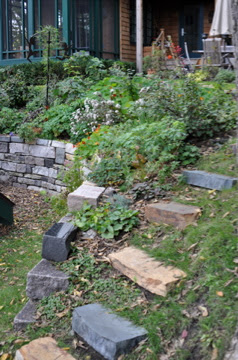Giving Tree Gardens has been busy building some exciting Minneapolis landscapes this summer. This pizza-oven and natural stone patio installation is the latest and greatest portion of the newly renovated Permaculture-made-pretty backyard living space at the Loomis residence in NE Minneapolis.
Team work pays off and this project brought together a great team of creative and skilled builders.
The lovely and functional pizza oven you see here was hand built by Minneapolis' own Frances Michaelson with rooftop construction help from her father, Paul Sylvester. Click here to veiw pictures of the oven construction. Built from locally sourced materials, including re-used street pavers, clay and sand from clients yards, beaver hewn logs from the Mississippi River's edge, and re-used tin roofing, this is an Earth-friendly permaculture landscape installation.
The pizza oven, patio, and roof-top are just a portion of the many changes that this back yard has undergone in one season. A Chicken coop, compost bins, fruit trees, a quaking aspen grove, rain-barrels, and butterfly gardens are all newly in place in this sustainable landscape.
For those who are wondering, you too can have a pizza oven built in your backyard. Click to view this page to learn more about our Backyard Pizza Oven services. Or Click here to schedule a home landscape consultation.
[nggallery id=9]















